Home / Degrees of Unsaturation (or IHD, Index of Hydrogen Deficiency)
Spectroscopy
Degrees of Unsaturation (or IHD, Index of Hydrogen Deficiency)
Last updated: June 9th, 2025 |
Degrees of Unsaturation (Index Of Hydrogen Deficiency)
- The molecular formula of a compound can give clues about its structure.
- The formula for an alkane follows the pattern CnHn+2 where n is the number of carbons.
- Every pi bond or ring reduces the number of hydrogens by 2.
- Therefore the molecular formula can tell us the number of pi bonds or rings in an unknown structure.
- This is called the index of hydrogen deficiency (IHD) or degrees of unsaturation.
- The full formula has modifications that account for halogens and nitrogens
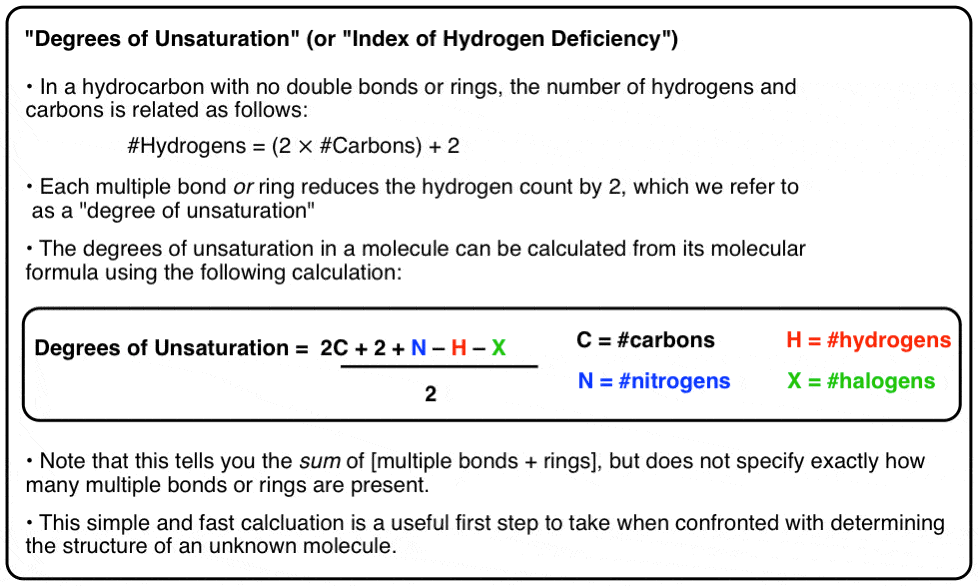
Table of Contents
- What’s So Great About The IHD?
- Playing Around With Molecular Formulae: Degrees of Unsaturation
- For A Hydrocarbon With No Rings Or Double Bonds The Number Of Hydrogens Is Equal To Twice The Number Of Carbons, Plus 2
- Each Double Bond or Ring Reduces The Hydrogen Count By 2
- Each Ring Or Double Bond Is Called A “Degree Of Unsaturation”
- Example: Benzene (4 Degrees Of Unsaturation)
- What About Molecules Containing Oxygen?
- What About Halogens?
- Nitrogen Is A Little Bit Tricky
- A Unified Formula For Degrees of Unsaturation
- Applying The IHD Formula To Four Real-Life Examples
- Quiz Yourself!
1. What’s So Great About The IHD?
The best thing about the IHD is that it is an easy equation to use that gives you useful information about the structure of an unknown compound. It literally takes a minute to do. Calculating the degrees of unsaturation is THE first task I recommend doing when you are faced with determining the structure of an unknown compound with a known molecular formula. In this post, we see that this calculation was clutch in the determination of the structure of the side chain of deer tarsal pheromone.
Before we get going, see if you can apply the equation in the box above to find the degrees of unsaturation in these extremely well known molecules whose formulae are given below.
- C9H8O4
- C21H30O2
- C17H21NO4
- C11H15NO2
The latter three molecules are somewhat “naughty” examples, being illegal in most, if not all states. Hopefully that’s an incentive for you to actually do the calculation! (answers at the bottom of the post).
2. Playing Around With Molecular Formulae: Degrees of Unsaturation
Let’s start this discussion by looking for patterns in molecular formulae. We’ll start with hydrocarbons containing no double bonds or rings.
Can you see a relationship between the number of carbons and the number of hydrogens?
More specifically, can you come up with a formula?
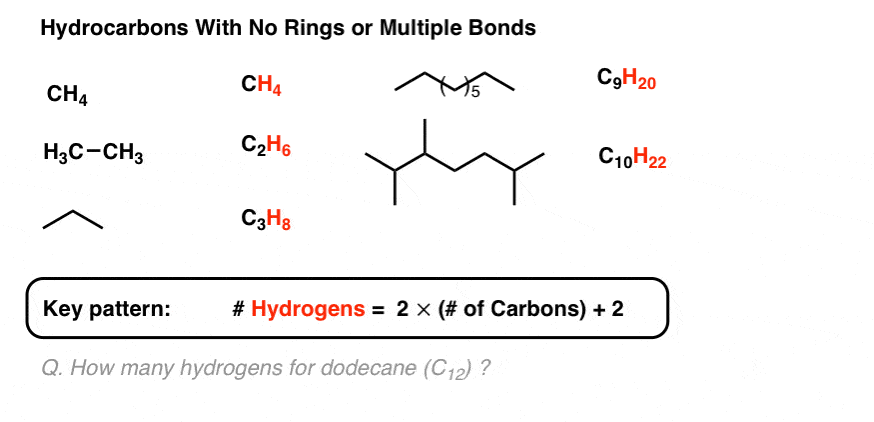
3. For A Hydrocarbon With No Rings Or Double Bonds The Number Of Hydrogens Is Equal To Twice The Number Of Carbons, Plus 2
You should be able to see that for a hydrocarbon with no rings or double bonds, the number of hydrogens is equal to twice the number of carbons, plus 2.
So for a molecule like dodecane (C12) we’d expect to see (12 x 2) + 2 = 26 hydrogens.
Now: what happens to the molecular formula when we add a double bond to the molecule?
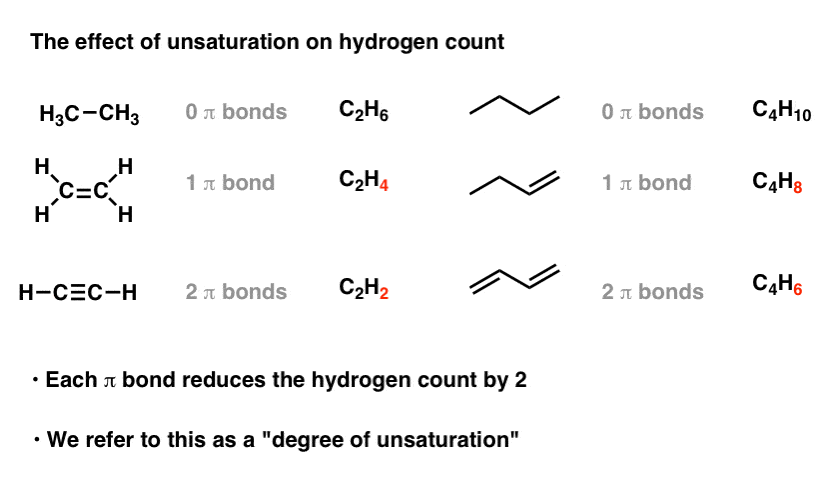
4. Each Double Bond or Ring Reduces The Hydrogen Count By 2
You should be able to see that each multiple bond (π bond ) the number of hydrogens in the formula decreases by two. Ethyne (2 π bonds) has two fewer hydrogens than ethene (1 π bond), which has two fewer hydrogens than ethane (zero π bonds).
Hydrocarbons containing π bonds are often called “unsaturated” hydrocarbons. They can be treated with hydrogen (Pd/C, H2 ) to give the corresponding alkane with no π bonds, which is then said to be “saturated” with hydrogen. (Compare “unsaturated fats“, which contain alkenes, and “saturated fats” which do not).
Since every pi bond results in a loss of 2 hydrogens from the molecular formula, we refer to this to as a “degree of unsaturation“.
Let’s turn our attention to cyclic compounds. Do you notice a similar effect?
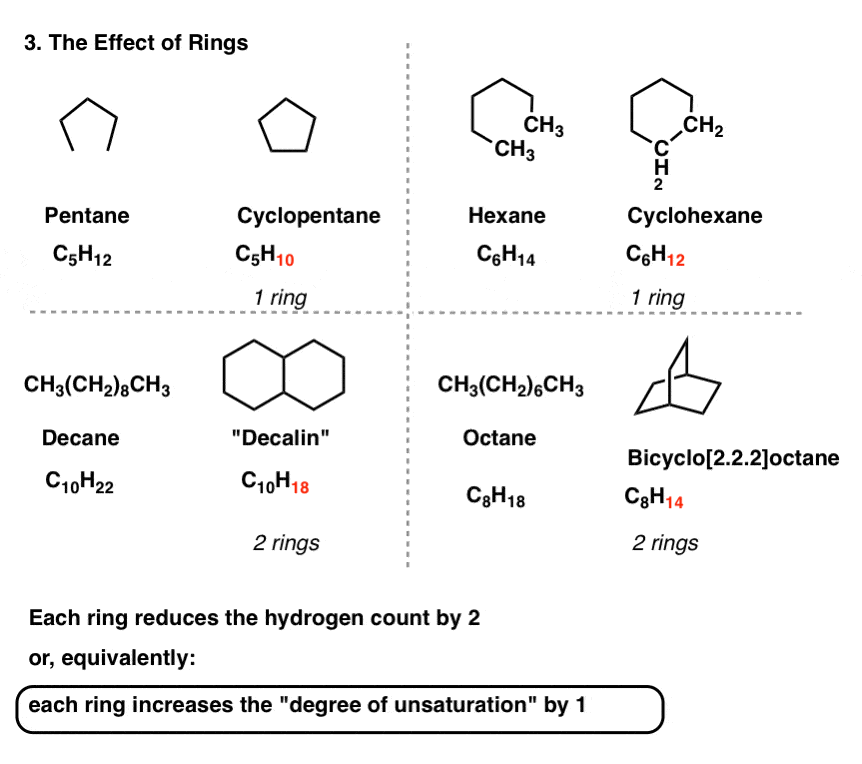
You should! Every ring in the molecule decreases the number of hydrogens by two.
5. Each Ring Or Double Bond Is Called A “Degree Of Unsaturation”
Therefore, each ring introduces a “degree of unsaturation” into the molecule.
You might ask: what if we have a molecule with rings and multiple bonds? See for yourself.
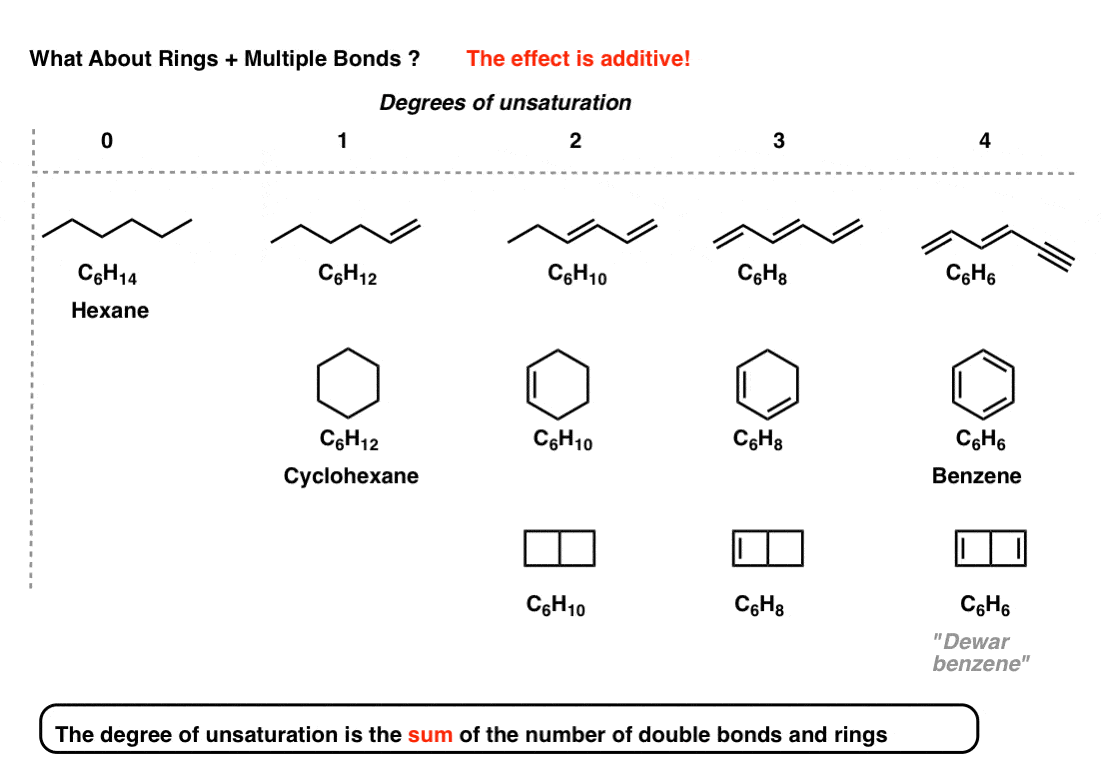
The effect is additive. That is, the “degrees of unsaturation” is the sum of the number of double bonds and rings.
Note that it doesn’t tell you how many double bonds are present or how many rings are present. It merely tells you their sum.
6. Example: Benzene (4 Degrees Of Unsaturation)
For instance, thus the molecular formula C6H6 (4 degrees of unsaturation) is satisfied by molecules with
- 4 pi bonds
- 3 pi bonds and a ring (benzene)
- two pi bonds and two rings (the very unstable Dewar Benzene, synthesized in 1963)
- one pi bond and three rings (the even more unstable benzvalene, a contact explosive, synthesized in 1971)
- and yes, even zero pi bonds and four rings (prismane, synthesized in 1973).
[Historical side note: the formula of benzene was known to be C6H6 from Michael Faraday in 1825, but the correct structure was not proposed until 1865 (Kekule) and not confirmed until 1929, by Catherine Lonsdale’s X-ray studies . Just a reminder that knowing the molecular formula only gets you so far. ]
Helpful hint: if you see 4 degrees of unsaturation in an unknown molecule, thinking “benzene ring” is a good place to start.
7. What About Molecules Containing Oxygen?
So far, so good. Let’s move on. What about molecules with oxygen?
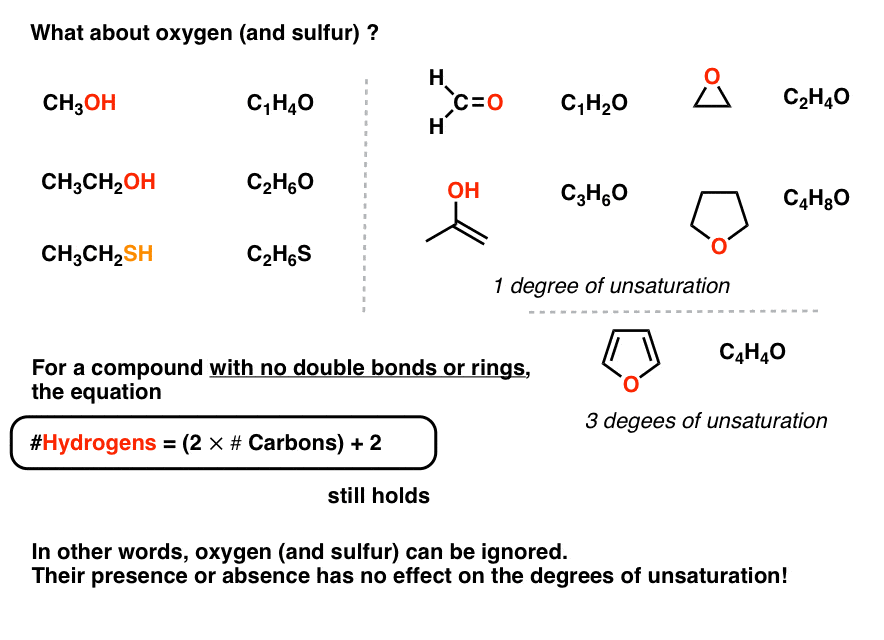
The same rules apply! We can calculate the number of hydrogens from the number of carbons as if the oxygen didn’t exist.
Note that a π bond which contains oxygen still counts as a “degree of unsaturation” (see formaldehyde, CH2O).
8. What About Halogens?
OK. What about halogens like chlorine, fluorine, iodine and bromine?
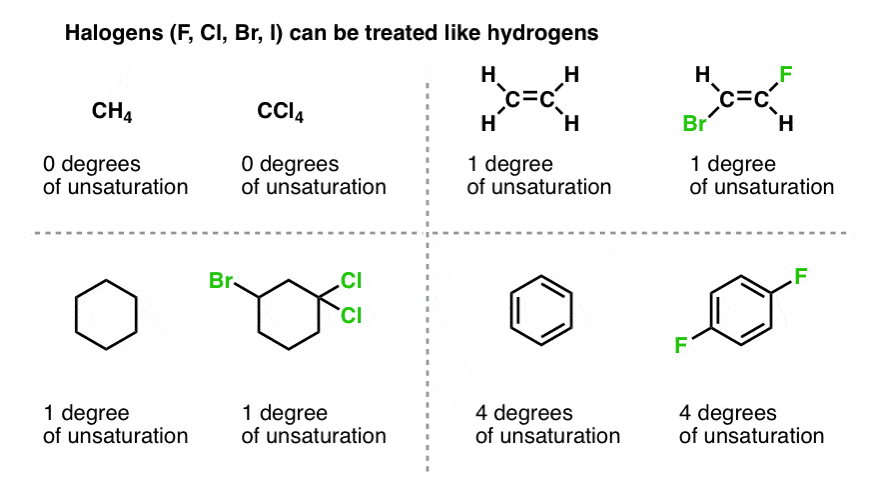
For the purposes of our formula relating hydrogens to carbons for molecules without rings or double bonds, halogens can be counted as hydrogens. That is, carbon tetrachloride (CCl4) has the same degrees of unsaturation (zero) as CH4.
We can thus modify the equation for a molecule with no double bonds or rings as follows:

9. Nitrogen Is A Little Bit Tricky
We’ve saved nitrogen for last, because it’s a bit weird. Try to see the pattern of how nitrogen affects our formula.
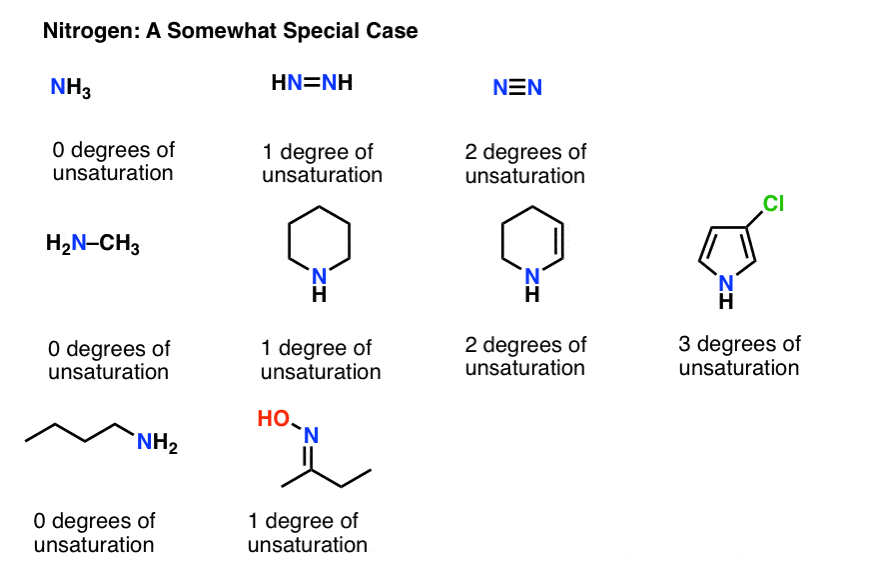
OK, you might have noticed that we can’t ignore nitrogen like we did oxygen.
The way to make the equation work with nitrogen is to add the nitrogen count to the right hand side of the equation, like this:

Try it with cadaverine (C5H14N2) which contains no double bonds or rings.
10. A Unified Formula For Degrees of Unsaturation
So far our equation has only applied to “saturated” compounds with no double bonds or rings.
How can we use this to make a general formula for “degrees of unsaturation”, which is actually… useful?
Math time. If we move the left hand side over to the right, we get this:
![]()
Zero equals the degrees of unsaturation in this case.
If we introduce a double bond or ring, the equation will return “2”.

Each successive degree of unsaturation will increase this number by 2. For instance, 2-chloropyridine C5H4NCl gives us 8:

Now 8 is not the degrees of unsaturation. It’s merely the number of hydrogens “missing” from the corresponding non-cyclic alkane of the same carbon count.
In order to make this equation give us the actual degrees of unsaturation, we need to divide everything by two.

We can really condense things by using the symbols H, C, N, and X to represent hydrogens, carbons, nitrogens and halogens, respectively.

This is our final form for the equation for “degrees of unsaturation”, or “index of hydrogen deficiency” if you prefer.
11. Applying The IHD Formula To Four Real-Life Examples
OK, now for those real-life examples I mentioned above.
- C9H8O4
- C21H30O2
- C17H21NO4
- C11H15NO2
Let’s plug each of them into our formula. You should get:
- C9H8O4 [6 degrees of unsaturation]
- C21H30O2 [7 degrees of unsaturation]
- C17H21NO4 [8 degrees of unsaturation]
- C11H15NO2 [5 degrees of unsaturation]
Now, let’s look at each of the molecules. You’ll find that the calculated degrees of unsaturation agrees with the sum of [multiple bonds and rings] in the molecule.
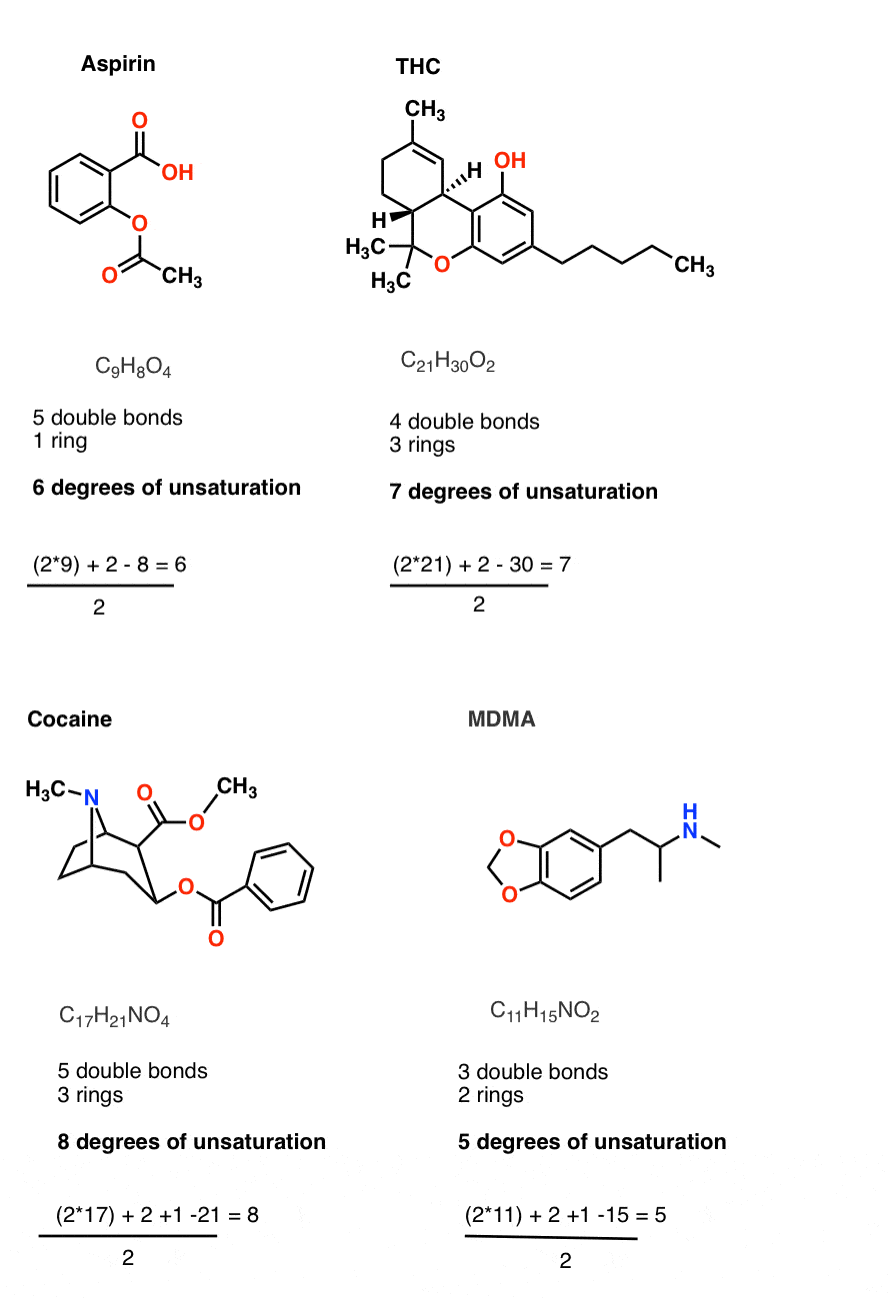
Super useful. Super easy.
With the structure in front of you it seems obvious. But if you’re dealing with an unknown it can be very helpful, like we saw with deer tarsal gland hormone in the last post.
In the next post, we’ll start delving into the mysteries of spectroscopy. We’ll start with one of the simplest spectroscopic techniques – UV-Vis spectroscopy – and show how it can be used to deliver clues about the structures of various molecules.
Notes
Related Articles
- Conjugation And Color (+ How Bleach Works)
- Infrared Spectroscopy: A Quick Primer On Interpreting Spectra
- Structure Determination Case Study: Deer Tarsal Gland Pheromone
- Introduction To UV-Vis Spectroscopy
- UV-Vis Spectroscopy: Practice Questions
- Alkene Addition Pattern #3: The “Concerted” Pathway
- Meet the (Most Important) Functional Groups
- Introduction to Cycloalkanes (1)
Quiz Yourself!
Quiz#: 2810
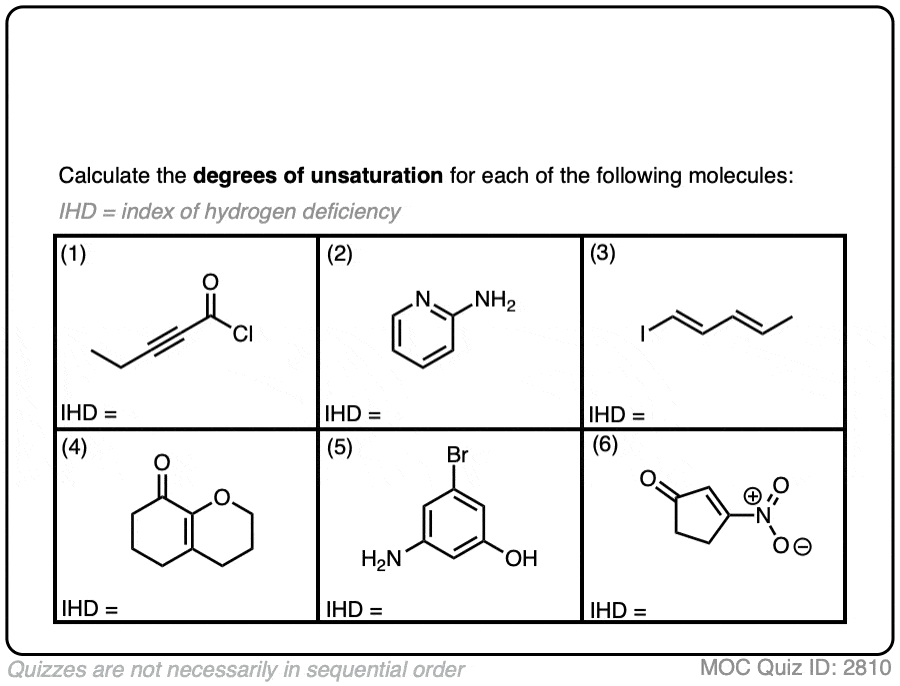 Click to Flip
Click to Flip
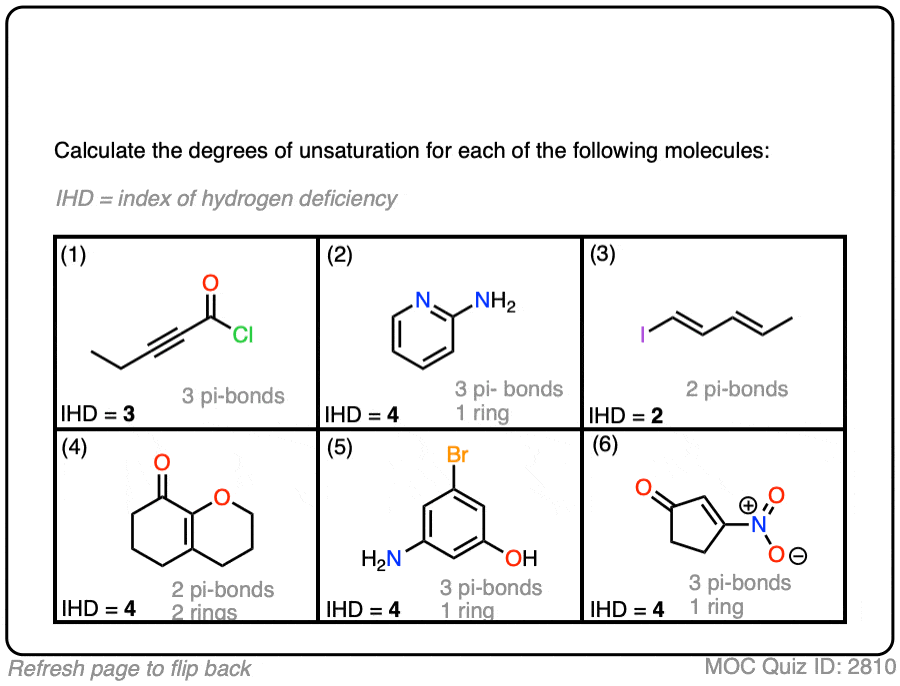
Quiz#: 2811
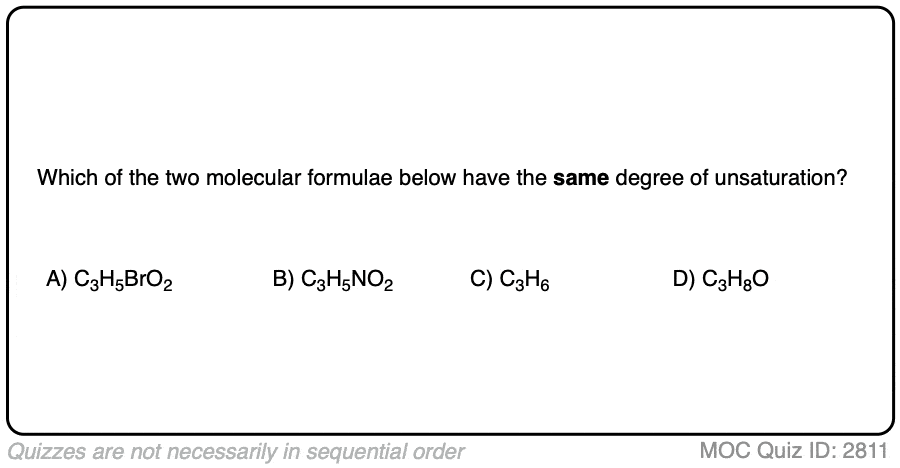 Click to Flip
Click to Flip
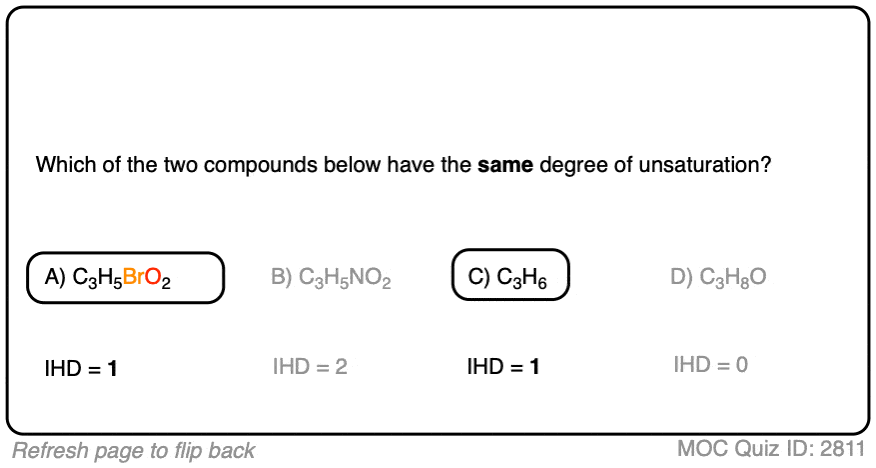
Quiz#: 2812
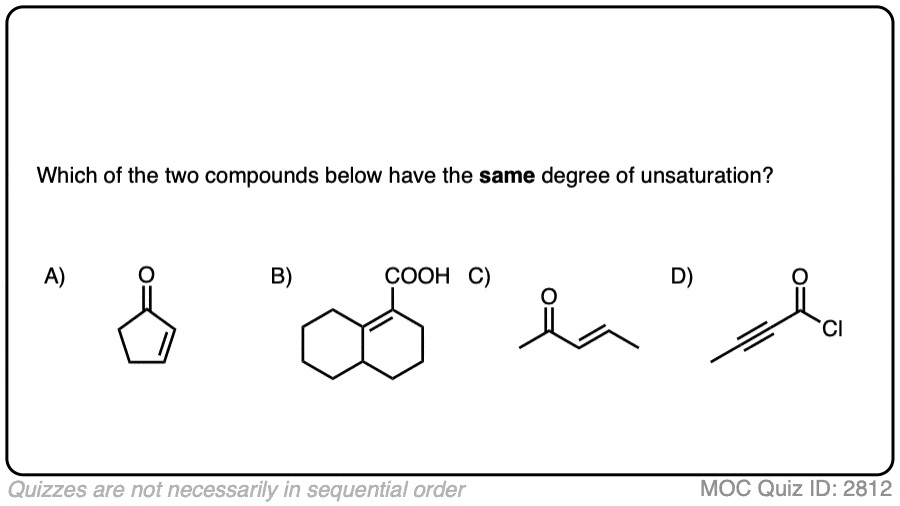 Click to Flip
Click to Flip
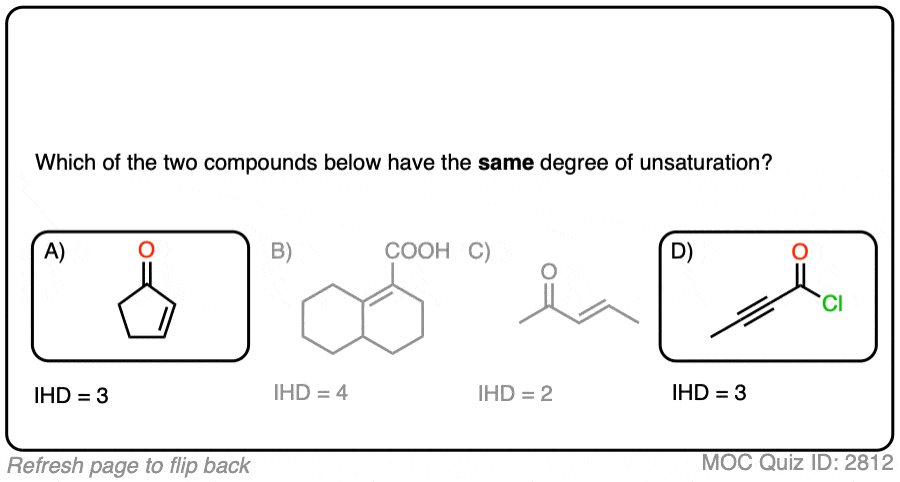
Quiz#: 2879
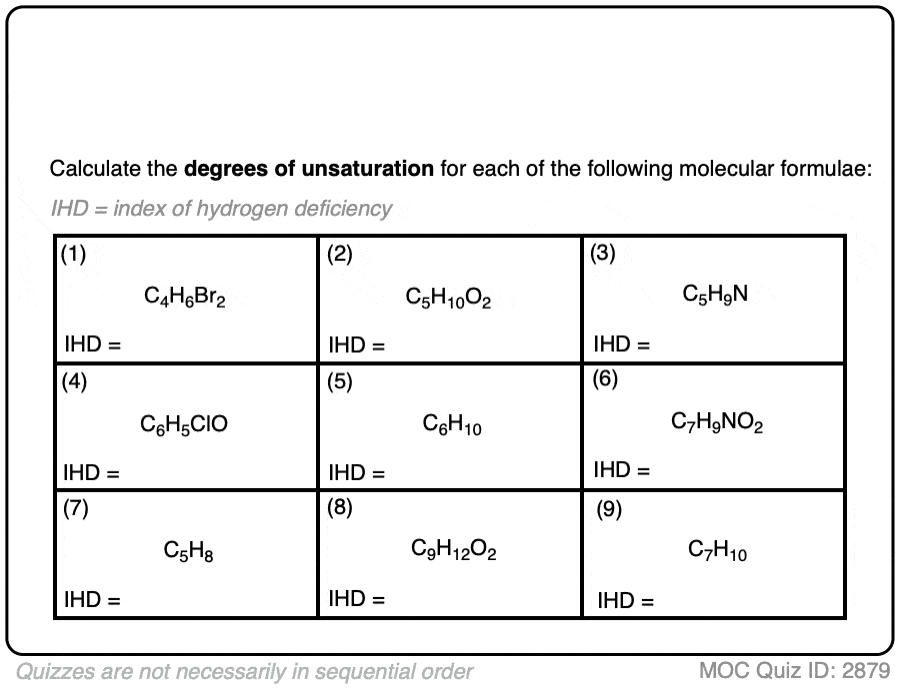 Click to Flip
Click to Flip
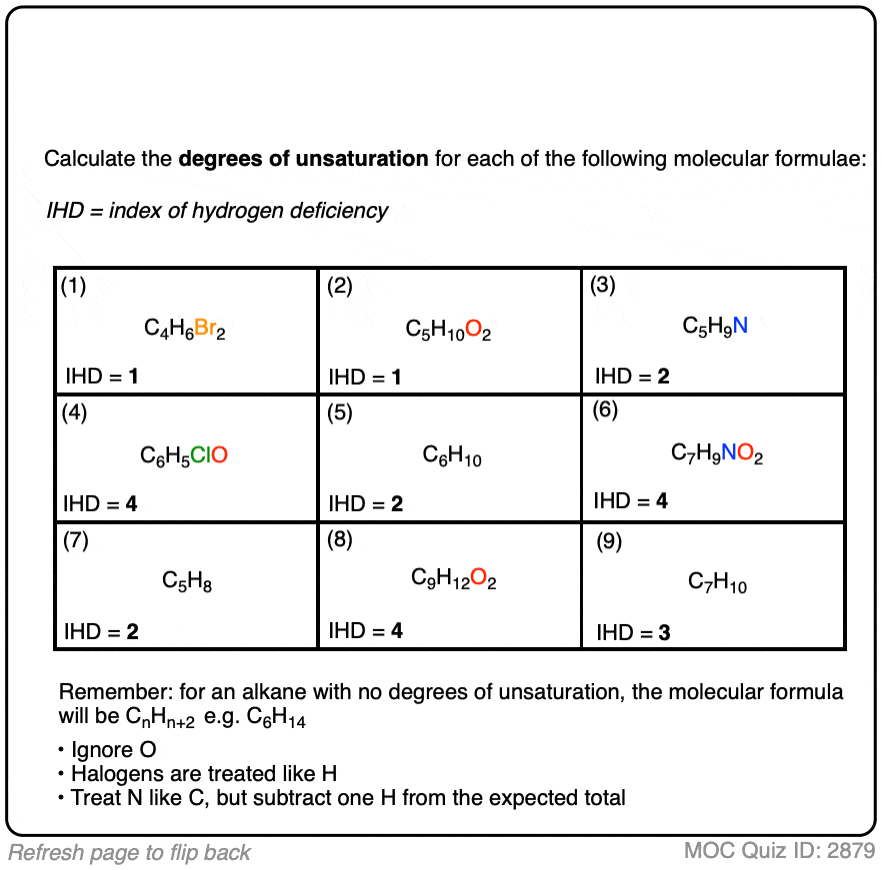
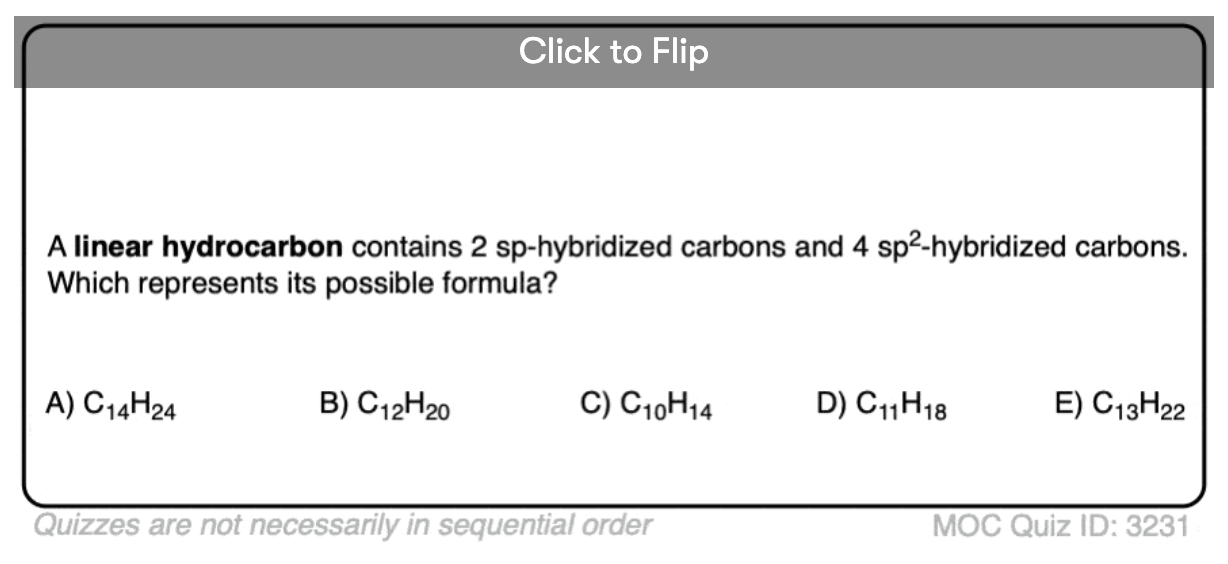
Become a MOC member to see the clickable quiz with answers on the back.
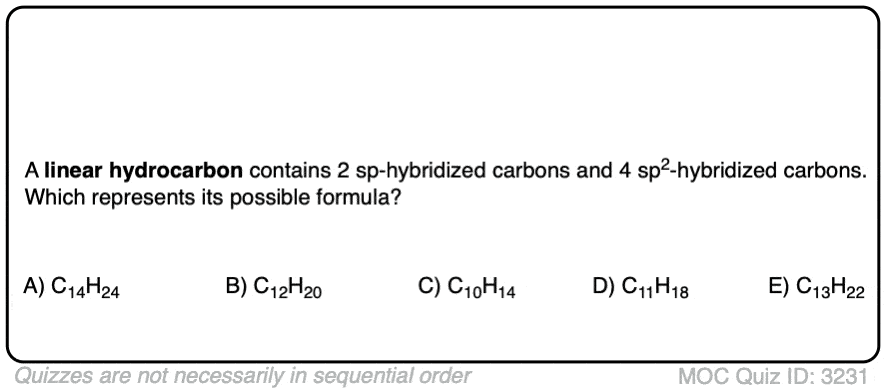 Click to Flip
Click to Flip
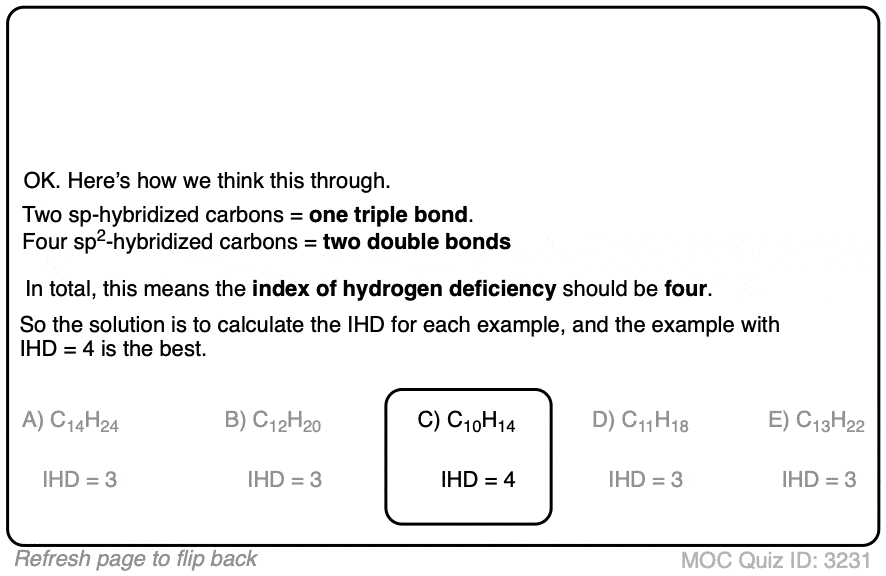
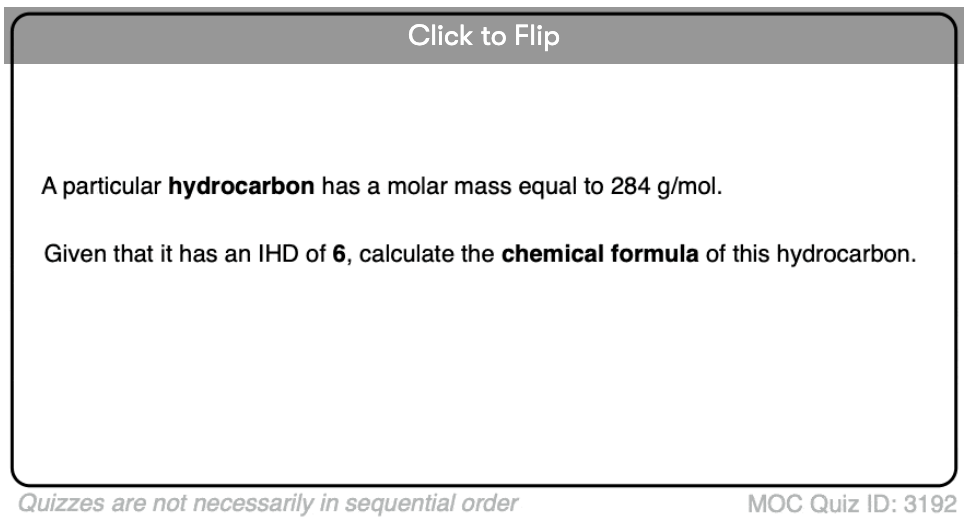
Become a MOC member to see the clickable quiz with answers on the back.
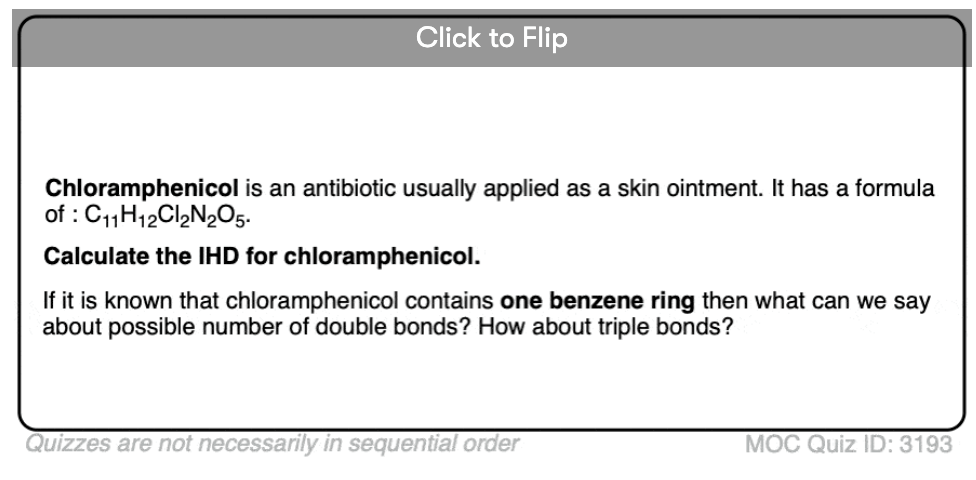
Become a MOC member to see the clickable quiz with answers on the back.
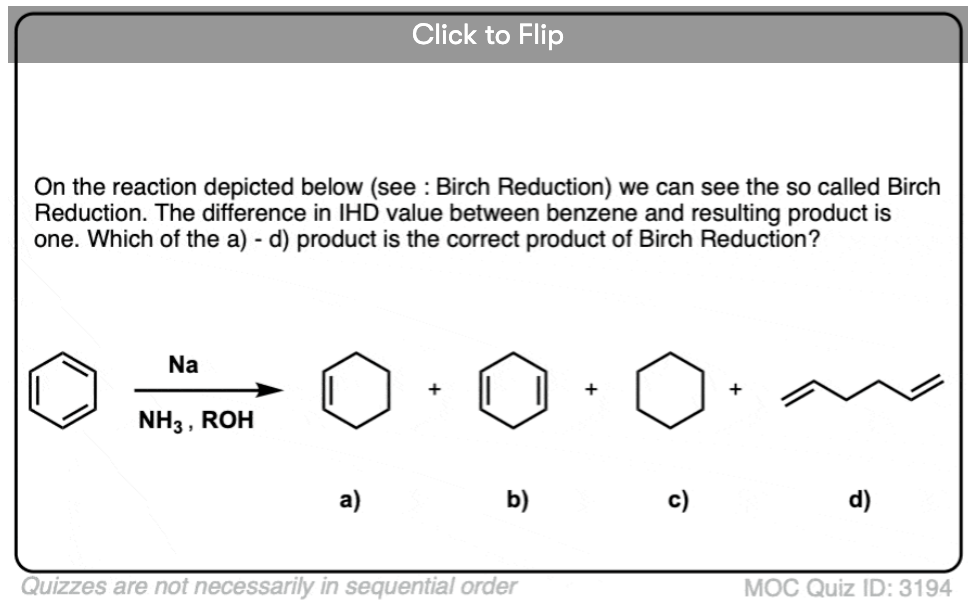
Become a MOC member to see the clickable quiz with answers on the back.
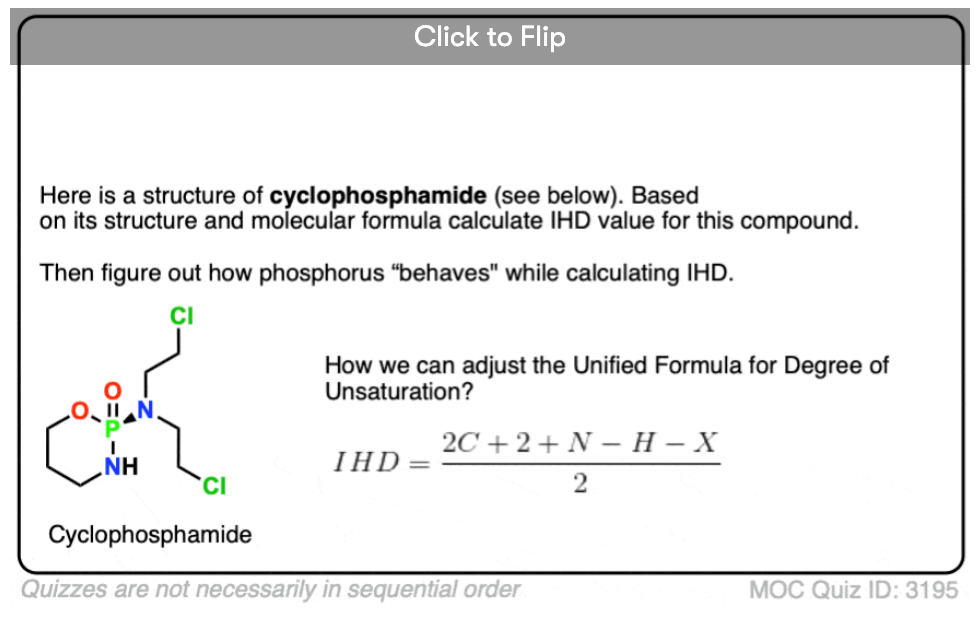
Become a MOC member to see the clickable quiz with answers on the back.
00 General Chemistry Review
01 Bonding, Structure, and Resonance
- How Do We Know Methane (CH4) Is Tetrahedral?
- Hybrid Orbitals and Hybridization
- How To Determine Hybridization: A Shortcut
- Orbital Hybridization And Bond Strengths
- Sigma bonds come in six varieties: Pi bonds come in one
- Dipole Moments and Dipoles
- A Key Skill: How to Calculate Formal Charge
- The Four Intermolecular Forces and How They Affect Boiling Points
- 3 Trends That Affect Boiling Points
- How To Use Electronegativity To Determine Electron Density (and why NOT to trust formal charge)
- Introduction to Resonance
- How To Use Curved Arrows To Interchange Resonance Forms
- Evaluating Resonance Forms (1) - The Rule of Least Charges
- How To Find The Best Resonance Structure By Applying Electronegativity
- Evaluating Resonance Structures With Negative Charges
- Evaluating Resonance Structures With Positive Charge
- Exploring Resonance: Pi-Donation
- Exploring Resonance: Pi-acceptors
- In Summary: Evaluating Resonance Structures
- Drawing Resonance Structures: 3 Common Mistakes To Avoid
- How to apply electronegativity and resonance to understand reactivity
- Bond Hybridization Practice
- Structure and Bonding Practice Quizzes
- Resonance Structures Practice
02 Acid Base Reactions
- Introduction to Acid-Base Reactions
- Acid Base Reactions In Organic Chemistry
- The Stronger The Acid, The Weaker The Conjugate Base
- Walkthrough of Acid-Base Reactions (3) - Acidity Trends
- Five Key Factors That Influence Acidity
- Acid-Base Reactions: Introducing Ka and pKa
- How to Use a pKa Table
- The pKa Table Is Your Friend
- A Handy Rule of Thumb for Acid-Base Reactions
- Acid Base Reactions Are Fast
- pKa Values Span 60 Orders Of Magnitude
- How Protonation and Deprotonation Affect Reactivity
- Acid Base Practice Problems
03 Alkanes and Nomenclature
- Meet the (Most Important) Functional Groups
- Condensed Formulas: Deciphering What the Brackets Mean
- Hidden Hydrogens, Hidden Lone Pairs, Hidden Counterions
- Don't Be Futyl, Learn The Butyls
- Primary, Secondary, Tertiary, Quaternary In Organic Chemistry
- Branching, and Its Affect On Melting and Boiling Points
- The Many, Many Ways of Drawing Butane
- Wedge And Dash Convention For Tetrahedral Carbon
- Common Mistakes in Organic Chemistry: Pentavalent Carbon
- Table of Functional Group Priorities for Nomenclature
- Summary Sheet - Alkane Nomenclature
- Organic Chemistry IUPAC Nomenclature Demystified With A Simple Puzzle Piece Approach
- Boiling Point Quizzes
- Organic Chemistry Nomenclature Quizzes
04 Conformations and Cycloalkanes
- Staggered vs Eclipsed Conformations of Ethane
- Conformational Isomers of Propane
- Newman Projection of Butane (and Gauche Conformation)
- Introduction to Cycloalkanes
- Geometric Isomers In Small Rings: Cis And Trans Cycloalkanes
- Calculation of Ring Strain In Cycloalkanes
- Cycloalkanes - Ring Strain In Cyclopropane And Cyclobutane
- Cyclohexane Conformations
- Cyclohexane Chair Conformation: An Aerial Tour
- How To Draw The Cyclohexane Chair Conformation
- The Cyclohexane Chair Flip
- The Cyclohexane Chair Flip - Energy Diagram
- Substituted Cyclohexanes - Axial vs Equatorial
- Ranking The Bulkiness Of Substituents On Cyclohexanes: "A-Values"
- Cyclohexane Chair Conformation Stability: Which One Is Lower Energy?
- Fused Rings - Cis-Decalin and Trans-Decalin
- Naming Bicyclic Compounds - Fused, Bridged, and Spiro
- Bredt's Rule (And Summary of Cycloalkanes)
- Newman Projection Practice
- Cycloalkanes Practice Problems
05 A Primer On Organic Reactions
- The Most Important Question To Ask When Learning a New Reaction
- Curved Arrows (for reactions)
- Nucleophiles and Electrophiles
- The Three Classes of Nucleophiles
- Nucleophilicity vs. Basicity
- What Makes A Good Nucleophile?
- What Makes A Good Leaving Group?
- 3 Factors That Stabilize Carbocations
- Equilibrium and Energy Relationships
- 7 Factors that stabilize negative charge in organic chemistry
- 7 Factors That Stabilize Positive Charge in Organic Chemistry
- What's a Transition State?
- Hammond's Postulate
- Learning Organic Chemistry Reactions: A Checklist (PDF)
06 Free Radical Reactions
- Free Radical Reactions
- 3 Factors That Stabilize Free Radicals
- Bond Strengths And Radical Stability
- Free Radical Initiation: Why Is "Light" Or "Heat" Required?
- Initiation, Propagation, Termination
- Monochlorination Products Of Propane, Pentane, And Other Alkanes
- Selectivity In Free Radical Reactions
- Selectivity in Free Radical Reactions: Bromination vs. Chlorination
- Halogenation At Tiffany's
- Allylic Bromination
- Bonus Topic: Allylic Rearrangements
- In Summary: Free Radicals
- Synthesis (2) - Reactions of Alkanes
- Free Radicals Practice Quizzes
07 Stereochemistry and Chirality
- Types of Isomers: Constitutional Isomers, Stereoisomers, Enantiomers, and Diastereomers
- How To Draw The Enantiomer Of A Chiral Molecule
- How To Draw A Bond Rotation
- Introduction to Assigning (R) and (S): The Cahn-Ingold-Prelog Rules
- Assigning Cahn-Ingold-Prelog (CIP) Priorities (2) - The Method of Dots
- Enantiomers vs Diastereomers vs The Same? Two Methods For Solving Problems
- Assigning R/S To Newman Projections (And Converting Newman To Line Diagrams)
- How To Determine R and S Configurations On A Fischer Projection
- The Meso Trap
- Optical Rotation, Optical Activity, and Specific Rotation
- Optical Purity and Enantiomeric Excess
- What's a Racemic Mixture?
- Chiral Allenes And Chiral Axes
- Stereochemistry Practice Problems and Quizzes
08 Substitution Reactions
- Nucleophilic Substitution Reactions - Introduction
- Two Types of Nucleophilic Substitution Reactions
- The SN2 Mechanism
- Why the SN2 Reaction Is Powerful
- The SN1 Mechanism
- The Conjugate Acid Is A Better Leaving Group
- Comparing the SN1 and SN2 Reactions
- Polar Protic? Polar Aprotic? Nonpolar? All About Solvents
- Steric Hindrance is Like a Fat Goalie
- Common Blind Spot: Intramolecular Reactions
- Substitution Practice - SN1
- Substitution Practice - SN2
09 Elimination Reactions
- Elimination Reactions (1): Introduction And The Key Pattern
- Elimination Reactions (2): The Zaitsev Rule
- Elimination Reactions Are Favored By Heat
- Two Elimination Reaction Patterns
- The E1 Reaction
- The E2 Mechanism
- E1 vs E2: Comparing the E1 and E2 Reactions
- Antiperiplanar Relationships: The E2 Reaction and Cyclohexane Rings
- Bulky Bases in Elimination Reactions
- Comparing the E1 vs SN1 Reactions
- Elimination (E1) Reactions With Rearrangements
- E1cB - Elimination (Unimolecular) Conjugate Base
- Elimination (E1) Practice Problems And Solutions
- Elimination (E2) Practice Problems and Solutions
10 Rearrangements
11 SN1/SN2/E1/E2 Decision
- Identifying Where Substitution and Elimination Reactions Happen
- Deciding SN1/SN2/E1/E2 (1) - The Substrate
- Deciding SN1/SN2/E1/E2 (2) - The Nucleophile/Base
- SN1 vs E1 and SN2 vs E2 : The Temperature
- Deciding SN1/SN2/E1/E2 - The Solvent
- Wrapup: The Key Factors For Determining SN1/SN2/E1/E2
- Alkyl Halide Reaction Map And Summary
- SN1 SN2 E1 E2 Practice Problems
12 Alkene Reactions
- E and Z Notation For Alkenes (+ Cis/Trans)
- Alkene Stability
- Alkene Addition Reactions: "Regioselectivity" and "Stereoselectivity" (Syn/Anti)
- Stereoselective and Stereospecific Reactions
- Hydrohalogenation of Alkenes and Markovnikov's Rule
- Hydration of Alkenes With Aqueous Acid
- Rearrangements in Alkene Addition Reactions
- Halogenation of Alkenes and Halohydrin Formation
- Oxymercuration Demercuration of Alkenes
- Hydroboration Oxidation of Alkenes
- m-CPBA (meta-chloroperoxybenzoic acid)
- OsO4 (Osmium Tetroxide) for Dihydroxylation of Alkenes
- Palladium on Carbon (Pd/C) for Catalytic Hydrogenation of Alkenes
- Cyclopropanation of Alkenes
- A Fourth Alkene Addition Pattern - Free Radical Addition
- Alkene Reactions: Ozonolysis
- Oxidative Cleavage of Vicinal Diols With NaIO4 and Pb(OAc)4
- Summary: Three Key Families Of Alkene Reaction Mechanisms
- Synthesis (4) - Alkene Reaction Map, Including Alkyl Halide Reactions
- Alkene Reactions Practice Problems
13 Alkyne Reactions
- Acetylides from Alkynes, And Substitution Reactions of Acetylides
- Partial Reduction of Alkynes With Lindlar's Catalyst
- Partial Reduction of Alkynes With Na/NH3 To Obtain Trans Alkenes
- Alkyne Hydroboration With "R2BH"
- Hydration and Oxymercuration of Alkynes
- Hydrohalogenation of Alkynes
- Alkyne Halogenation: Bromination and Chlorination of Alkynes
- Oxidation of Alkynes With O3 and KMnO4
- Alkenes To Alkynes Via Halogenation And Elimination Reactions
- Alkynes Are A Blank Canvas
- Synthesis (5) - Reactions of Alkynes
- Alkyne Reactions Practice Problems With Answers
14 Alcohols, Epoxides and Ethers
- Alcohols - Nomenclature and Properties
- Alcohols Can Act As Acids Or Bases (And Why It Matters)
- Alcohols - Acidity and Basicity
- The Williamson Ether Synthesis
- Ethers From Alkenes, Tertiary Alkyl Halides and Alkoxymercuration
- Alcohols To Ethers via Acid Catalysis
- Cleavage Of Ethers With Acid
- Epoxides - The Outlier Of The Ether Family
- Opening of Epoxides With Acid
- Epoxide Ring Opening With Base
- Making Alkyl Halides From Alcohols
- Tosylates And Mesylates
- PBr3 and SOCl2
- Elimination Reactions of Alcohols
- Elimination of Alcohols To Alkenes With POCl3
- Alcohol Oxidation: "Strong" and "Weak" Oxidants
- Demystifying The Mechanisms of Alcohol Oxidations
- Protecting Groups For Alcohols
- Thiols And Thioethers
- Calculating the oxidation state of a carbon
- Oxidation and Reduction in Organic Chemistry
- Oxidation Ladders
- SOCl2 Mechanism For Alcohols To Alkyl Halides: SN2 versus SNi
- Alcohol Reactions Roadmap (PDF)
- Alcohol Reaction Practice Problems
- Epoxide Reaction Quizzes
- Oxidation and Reduction Practice Quizzes
15 Organometallics
- What's An Organometallic?
- Formation of Grignard and Organolithium Reagents
- Organometallics Are Strong Bases
- Reactions of Grignard Reagents
- Protecting Groups In Grignard Reactions
- Synthesis Problems Involving Grignard Reagents
- Grignard Reactions And Synthesis (2)
- Organocuprates (Gilman Reagents): How They're Made
- Gilman Reagents (Organocuprates): What They're Used For
- The Heck, Suzuki, and Olefin Metathesis Reactions (And Why They Don't Belong In Most Introductory Organic Chemistry Courses)
- Reaction Map: Reactions of Organometallics
- Grignard Practice Problems
16 Spectroscopy
- Degrees of Unsaturation (or IHD, Index of Hydrogen Deficiency)
- Conjugation And Color (+ How Bleach Works)
- Introduction To UV-Vis Spectroscopy
- UV-Vis Spectroscopy: Absorbance of Carbonyls
- UV-Vis Spectroscopy: Practice Questions
- Bond Vibrations, Infrared Spectroscopy, and the "Ball and Spring" Model
- Infrared (IR) Spectroscopy: A Quick Primer On Interpreting Spectra
- IR Spectroscopy: 4 Practice Problems
- 1H NMR: How Many Signals?
- Homotopic, Enantiotopic, Diastereotopic
- Diastereotopic Protons in 1H NMR Spectroscopy: Examples
- 13-C NMR - How Many Signals
- Liquid Gold: Pheromones In Doe Urine
- Natural Product Isolation (1) - Extraction
- Natural Product Isolation (2) - Purification Techniques, An Overview
- Structure Determination Case Study: Deer Tarsal Gland Pheromone
17 Dienes and MO Theory
- What To Expect In Organic Chemistry 2
- Are these molecules conjugated?
- Conjugation And Resonance In Organic Chemistry
- Bonding And Antibonding Pi Orbitals
- Molecular Orbitals of The Allyl Cation, Allyl Radical, and Allyl Anion
- Pi Molecular Orbitals of Butadiene
- Reactions of Dienes: 1,2 and 1,4 Addition
- Thermodynamic and Kinetic Products
- More On 1,2 and 1,4 Additions To Dienes
- s-cis and s-trans
- The Diels-Alder Reaction
- Cyclic Dienes and Dienophiles in the Diels-Alder Reaction
- Stereochemistry of the Diels-Alder Reaction
- Exo vs Endo Products In The Diels Alder: How To Tell Them Apart
- HOMO and LUMO In the Diels Alder Reaction
- Why Are Endo vs Exo Products Favored in the Diels-Alder Reaction?
- Diels-Alder Reaction: Kinetic and Thermodynamic Control
- The Retro Diels-Alder Reaction
- The Intramolecular Diels Alder Reaction
- Regiochemistry In The Diels-Alder Reaction
- The Cope and Claisen Rearrangements
- Electrocyclic Reactions
- Electrocyclic Ring Opening And Closure (2) - Six (or Eight) Pi Electrons
- Diels Alder Practice Problems
- Molecular Orbital Theory Practice
18 Aromaticity
- Introduction To Aromaticity
- Rules For Aromaticity
- Huckel's Rule: What Does 4n+2 Mean?
- Aromatic, Non-Aromatic, or Antiaromatic? Some Practice Problems
- Antiaromatic Compounds and Antiaromaticity
- The Pi Molecular Orbitals of Benzene
- The Pi Molecular Orbitals of Cyclobutadiene
- Frost Circles
- Aromaticity Practice Quizzes
19 Reactions of Aromatic Molecules
- Electrophilic Aromatic Substitution: Introduction
- Activating and Deactivating Groups In Electrophilic Aromatic Substitution
- Electrophilic Aromatic Substitution - The Mechanism
- Ortho-, Para- and Meta- Directors in Electrophilic Aromatic Substitution
- Understanding Ortho, Para, and Meta Directors
- Why are halogens ortho- para- directors?
- Disubstituted Benzenes: The Strongest Electron-Donor "Wins"
- Electrophilic Aromatic Substitutions (1) - Halogenation of Benzene
- Electrophilic Aromatic Substitutions (2) - Nitration and Sulfonation
- EAS Reactions (3) - Friedel-Crafts Acylation and Friedel-Crafts Alkylation
- Intramolecular Friedel-Crafts Reactions
- Nucleophilic Aromatic Substitution (NAS)
- Nucleophilic Aromatic Substitution (2) - The Benzyne Mechanism
- Reactions on the "Benzylic" Carbon: Bromination And Oxidation
- The Wolff-Kishner, Clemmensen, And Other Carbonyl Reductions
- More Reactions on the Aromatic Sidechain: Reduction of Nitro Groups and the Baeyer Villiger
- Aromatic Synthesis (1) - "Order Of Operations"
- Synthesis of Benzene Derivatives (2) - Polarity Reversal
- Aromatic Synthesis (3) - Sulfonyl Blocking Groups
- Birch Reduction
- Synthesis (7): Reaction Map of Benzene and Related Aromatic Compounds
- Aromatic Reactions and Synthesis Practice
- Electrophilic Aromatic Substitution Practice Problems
20 Aldehydes and Ketones
- What's The Alpha Carbon In Carbonyl Compounds?
- Nucleophilic Addition To Carbonyls
- Aldehydes and Ketones: 14 Reactions With The Same Mechanism
- Sodium Borohydride (NaBH4) Reduction of Aldehydes and Ketones
- Grignard Reagents For Addition To Aldehydes and Ketones
- Wittig Reaction
- Hydrates, Hemiacetals, and Acetals
- Imines - Properties, Formation, Reactions, and Mechanisms
- All About Enamines
- Breaking Down Carbonyl Reaction Mechanisms: Reactions of Anionic Nucleophiles (Part 2)
- Aldehydes Ketones Reaction Practice
21 Carboxylic Acid Derivatives
- Nucleophilic Acyl Substitution (With Negatively Charged Nucleophiles)
- Addition-Elimination Mechanisms With Neutral Nucleophiles (Including Acid Catalysis)
- Basic Hydrolysis of Esters - Saponification
- Transesterification
- Proton Transfer
- Fischer Esterification - Carboxylic Acid to Ester Under Acidic Conditions
- Lithium Aluminum Hydride (LiAlH4) For Reduction of Carboxylic Acid Derivatives
- LiAlH[Ot-Bu]3 For The Reduction of Acid Halides To Aldehydes
- Di-isobutyl Aluminum Hydride (DIBAL) For The Partial Reduction of Esters and Nitriles
- Amide Hydrolysis
- Thionyl Chloride (SOCl2) And Conversion of Carboxylic Acids to Acid Halides
- Diazomethane (CH2N2)
- Carbonyl Chemistry: Learn Six Mechanisms For the Price Of One
- Making Music With Mechanisms (PADPED)
- Carboxylic Acid Derivatives Practice Questions
22 Enols and Enolates
- Keto-Enol Tautomerism
- Enolates - Formation, Stability, and Simple Reactions
- Kinetic Versus Thermodynamic Enolates
- Aldol Addition and Condensation Reactions
- Reactions of Enols - Acid-Catalyzed Aldol, Halogenation, and Mannich Reactions
- Claisen Condensation and Dieckmann Condensation
- Decarboxylation
- The Malonic Ester and Acetoacetic Ester Synthesis
- The Michael Addition Reaction and Conjugate Addition
- The Robinson Annulation
- Haloform Reaction
- The Hell–Volhard–Zelinsky Reaction
- Enols and Enolates Practice Quizzes
23 Amines
- The Amide Functional Group: Properties, Synthesis, and Nomenclature
- Basicity of Amines And pKaH
- 5 Key Basicity Trends of Amines
- The Mesomeric Effect And Aromatic Amines
- Nucleophilicity of Amines
- Alkylation of Amines (Sucks!)
- Reductive Amination
- The Gabriel Synthesis
- Some Reactions of Azides
- The Hofmann Elimination
- The Hofmann and Curtius Rearrangements
- The Cope Elimination
- Protecting Groups for Amines - Carbamates
- The Strecker Synthesis of Amino Acids
- Introduction to Peptide Synthesis
- Reactions of Diazonium Salts: Sandmeyer and Related Reactions
- Amine Practice Questions
24 Carbohydrates
- D and L Notation For Sugars
- Pyranoses and Furanoses: Ring-Chain Tautomerism In Sugars
- What is Mutarotation?
- Reducing Sugars
- The Big Damn Post Of Carbohydrate-Related Chemistry Definitions
- The Haworth Projection
- Converting a Fischer Projection To A Haworth (And Vice Versa)
- Reactions of Sugars: Glycosylation and Protection
- The Ruff Degradation and Kiliani-Fischer Synthesis
- Isoelectric Points of Amino Acids (and How To Calculate Them)
- Carbohydrates Practice
- Amino Acid Quizzes
25 Fun and Miscellaneous
- A Gallery of Some Interesting Molecules From Nature
- Screw Organic Chemistry, I'm Just Going To Write About Cats
- On Cats, Part 1: Conformations and Configurations
- On Cats, Part 2: Cat Line Diagrams
- On Cats, Part 4: Enantiocats
- On Cats, Part 6: Stereocenters
- Organic Chemistry Is Shit
- The Organic Chemistry Behind "The Pill"
- Maybe they should call them, "Formal Wins" ?
- Why Do Organic Chemists Use Kilocalories?
- The Principle of Least Effort
- Organic Chemistry GIFS - Resonance Forms
- Reproducibility In Organic Chemistry
- What Holds The Nucleus Together?
- How Reactions Are Like Music
- Organic Chemistry and the New MCAT
26 Organic Chemistry Tips and Tricks
- Common Mistakes: Formal Charges Can Mislead
- Partial Charges Give Clues About Electron Flow
- Draw The Ugly Version First
- Organic Chemistry Study Tips: Learn the Trends
- The 8 Types of Arrows In Organic Chemistry, Explained
- Top 10 Skills To Master Before An Organic Chemistry 2 Final
- Common Mistakes with Carbonyls: Carboxylic Acids... Are Acids!
- Planning Organic Synthesis With "Reaction Maps"
- Alkene Addition Pattern #1: The "Carbocation Pathway"
- Alkene Addition Pattern #2: The "Three-Membered Ring" Pathway
- Alkene Addition Pattern #3: The "Concerted" Pathway
- Number Your Carbons!
- The 4 Major Classes of Reactions in Org 1
- How (and why) electrons flow
- Grossman's Rule
- Three Exam Tips
- A 3-Step Method For Thinking Through Synthesis Problems
- Putting It Together
- Putting Diels-Alder Products in Perspective
- The Ups and Downs of Cyclohexanes
- The Most Annoying Exceptions in Org 1 (Part 1)
- The Most Annoying Exceptions in Org 1 (Part 2)
- The Marriage May Be Bad, But the Divorce Still Costs Money
- 9 Nomenclature Conventions To Know
- Nucleophile attacks Electrophile
27 Case Studies of Successful O-Chem Students
- Success Stories: How Corina Got The The "Hard" Professor - And Got An A+ Anyway
- How Helena Aced Organic Chemistry
- From a "Drop" To B+ in Org 2 – How A Hard Working Student Turned It Around
- How Serge Aced Organic Chemistry
- Success Stories: How Zach Aced Organic Chemistry 1
- Success Stories: How Kari Went From C– to B+
- How Esther Bounced Back From a "C" To Get A's In Organic Chemistry 1 And 2
- How Tyrell Got The Highest Grade In Her Organic Chemistry Course
- This Is Why Students Use Flashcards
- Success Stories: How Stu Aced Organic Chemistry
- How John Pulled Up His Organic Chemistry Exam Grades
- Success Stories: How Nathan Aced Organic Chemistry (Without It Taking Over His Life)
- How Chris Aced Org 1 and Org 2
- Interview: How Jay Got an A+ In Organic Chemistry
- How to Do Well in Organic Chemistry: One Student's Advice
- "America's Top TA" Shares His Secrets For Teaching O-Chem
- "Organic Chemistry Is Like..." - A Few Metaphors
- How To Do Well In Organic Chemistry: Advice From A Tutor
- Guest post: "I went from being afraid of tests to actually looking forward to them".
The formula DU = (No. of Rings + No. of pi bonds) is not always true. But analysis of DU from molecular formula always holds.
Example: For cage-like compounds like Cubane (C8H8) or Frisbane, molecular formula analysis gives us the DU to be 5. But by seeing the structure, as there are 6 sides and thus 6 rings in a cubane, we can say DU to be 6.
The plausible explanation I got for this is that as we remove the 5th molecule of H2 to form the fifth ring, the sixth ring forms simultaneously without any need for further removal of H2.
Please correct me if I am wrong.
I read that in Dewar benzene, the middle C1-C4 linkage in not sigma bond but 2p-2p pi bond (special type of pi without sigma).
In compound R-NO2 (suppose R is an aliphatic saturated compound), will the degree of unsaturation be 1 or 1.5? Shouldn’t we take DU equal to 1.5 due to resonance between the negative charge of oxygen atom and the double bond?
Which one is correct? Sorry to ask a silly question.
I have been struggling with using IHD to deduce a structural fromula from a spectrum graph.
Your explanation has help me a lot.
Thank you.
First problem to be solved using simultaneous equations in two variables.
A hydrocarbon contains only two elements, viz C and H. Let the formula be CxHy.
Given IHD= 6.
Substitute in IHD formula and get the first simultaneous equation as
2x+2+-y= 6
Atomic weights of C=12 and H=1. Substitute to calculate formula weight and get 2nd equation in two variables
12x + y = 284.
solve for x and y
Sir is there any subtraction or for functional group?
No, it’s done on an atom-by-atom basis
If we’re given the structure of the molecule, can’t we just calculate degrees of unsaturation by the formula:
IHD = #rings + #double bonds + 2#triple bonds
If we only have the molecular formula, this formula isn’t helpful. But if we have the structure, isn’t this formula more simple?
Hi Chris – This is a post about structure determination.
The usefulness of IHD is that it is a value you can calculate from the molecular formula without knowing anything else about the structure (the molecular formula can be obtained from techniques like elemental analysis, high-resolution mass spectrometry, etc.)
That’s why I say it’s one of the first calculations to make when you’re dealing with a molecule of unknown structure.
If you already know the structure, then IHD isn’t really going to help you
I once came a cross a question,
which spoke of degrees of unsaturation for,
the oxalate ion, not the acid, beware.
The answer spoke of degrees 3, not 2,
as the anionic oxygens could pick up a H2 too,
I’d like to know if this accepted and right,
Pray do clear my plight!
That is very clever!
To be a fair question, however, it should specify the counter-ions. For sodium oxalate, Na+ would be the same as H+ and provide an answer of 2 for C2O4Na2
Can you explain what a degree of unsaturation of 6 mean? I calculated the degree of unsaturation for C7H5NO3 but I am a bit confused on what a DoU =6 means for the compound’s structure?
It means the the number of [rings + multiple bonds] is equal to 6. That means it could have 6 rings and no double bonds, 5 rings and one multiple bond…. all the way to zero rings and six multiple bonds.
A quick hint: a benzene ring takes up 4 degrees of unsaturation [1 ring and 3 double bonds], so I would start there. That leaves you with 5 hydrogens, a nitrogen and 3 oxygens to put on the benzene ring…
Can you please show the steps for the first problem? 284 molar mass and degree of saturation 6?
I’m really thankful for you, I didn’t know What the degrees of unsaturation was and useful, now I know because of you, and it’s very helpful for me to identify molecules by IR spectres given to me as a hometask
OK. Glad you found the website helpful Dadahon.
Thanks so much. Really helpful
Thanks James.
You made a mistake in your formula for cocaine and MDMA, you are subtracting the nitrogen instead of adding it… The answer you get is correct, but the operation indicated is incorrect.
Thank you.
I’m sorry you didn’t get the faculty positions you applied for, especially after all of that post-graduate work. All the same, your posts are the truth! Great examples, great explanations. It all makes so much sense now that I think I’ll actually be able to get an A on my Ochem exam.
Thanks again!
Renee
It was truly great!!!! I got all of it and it was really really helpful!
Thanks a lot!
It is not true when we have anion and catiuon
Can you post a specific example? That would be helpful. I’m not saying you’re wrong, by the way.